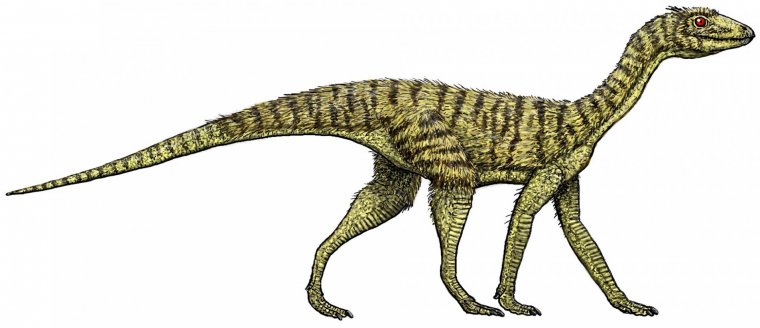| News / Science News |
Shaking the dinosaur family tree: how did ‘bird-hipped’ dinosaurs evolve?
Researchers have conducted a new analysis of the origins of ‘bird-hipped’ dinosaurs – the group which includes iconic species such as Triceratops – and found that they likely evolved from a group of animals known as silesaurs, which were first identified two decades ago.

Silesaurus opolensis flipped. Photo: Dr. Jeff Martz/NPS
The researchers, from the University of Cambridge and the Universidade Federal de Santa Maria in Brazil, were attempting to solve a long-standing mystery in palaeontology: where the ‘bird-hipped’ dinosaurs, or ornithischians, came from.
Currently, there is a gap of more than 25 million years in the fossil record, making it difficult to find the branch of the dinosaur family tree where ornithischians belong.
The researchers conducted an extensive analysis of early dinosaurs as well as silesaurs, a group named after Silesaurus, first described in 2003.
The researchers suggest that silesaurs progressively modified their anatomy during the Late Triassic Period, so that they came to resemble ornithischians by the Early Jurassic Period.
However, these ornithischian ancestors have the hip structure of the ‘lizard-hipped’ dinosaurs, or saurischians, suggesting that the earliest bird-hipped dinosaurs were in fact lizard-hipped.
Dinosaurs originated in the Late Triassic period, about 225 million years ago, and dominated life on Earth until a mass extinction event 66 million years ago. Dinosaurs have fascinated us since they were first named as such by Richard Owen in 1842.
The earliest discovered dinosaur remains were scrappy: odd-looking teeth and a few bones. By the latter half of the 19th century however, enough dinosaur remains had been found that a classification system was needed.
Harry Seeley, who had been trained in Cambridge by Adam Sedgwick, developed such a classification of dinosaurs based primarily upon the shape of their hip bones: they were either saurischians (lizard-hipped) or ornithischians (bird-hipped).
This classification, first published in 1888, proved reliable: all dinosaur discoveries seemed to slot neatly into one or other of these groupings.
However, in 2017, Professor David Norman from Cambridge’s Department of Earth Sciences and his former PhD students Matthew Baron and Paul Barrett argued that these dinosaur family groupings need to be rearranged, re-defined and re-named.
In a study, the researchers suggested that bird-hipped dinosaurs and lizard-hipped dinosaurs such as Tyrannosaurus evolved from a common ancestor, potentially overturning more than a century of theory about the evolutionary history of dinosaurs.
Controversy aside, it has long been recognised that the bird-hipped dinosaurs are anatomically distinct from all other types of dinosaurs, even though they have nothing to do with birds. But how they came to be has remained a long-standing problem.
Recent work has begun to indicate a more varied and puzzling picture of ornithischian origins. From a phylogenetic perspective – how the dinosaur family tree branches over time – it is predicted that ornithischian remains should first appear in the fossil record about 225 million years ago.
“However, the more we’ve looked in rocks of that age, the less we’ve found,” said Norman, who is a Fellow of Christ’s College. “The first unarguable ornithischian remains date from less than 200 million years ago, meaning there is a 25+ million-year ornithischian gap. So far, all attempts to fill that gap have failed.”
One solution to this conundrum can be traced back to a discovery in the early years of this century, when the skeleton of an unusual Late Triassic dinosaur-like animal was discovered in Poland. It was described by Jerzy Dzik and named Silesaurus (the ‘Silesian lizard’).
Silesaurus has long slender legs that gave it an upright dinosaur-like posture – and its hip bones are arranged like a saurischian – but it seemed to have a toothless, beak-like region at the front of its lower jaw.
This was not unlike the toothless beak-like structure known as a predentary that is found in all ornithischian dinosaur skulls, although the uniquely ornithischian predentary bone was not present.
Its teeth were also constricted at the top of the roots, and the crowns of the teeth were leaf-shaped in profile: a type of tooth shape seen in many early ornithischians.
Dzik speculated about the possible ornithischian similarities of Silesaurus, but the suggestion was dismissed or ignored by most researchers.
In the years that followed, more Silesaurus-like creatures were discovered, mostly in South America. Many of these specimens were fragments, but the toothless tip of the lower jaw and the leaf-shaped teeth were common.
The analyses suggested that silesaurs were close relatives of true dinosaurs. Either they were placed on a branch just before the origin of true dinosaurs or, in some instances, they appeared as a sister group to Ornithischia.
In 2020, Mauricio Garcia and Rodrigo Müller from the Universidade Federal de Santa Maria in Brazil proposed that silesaur-like creatures could sit on the branch of Dinosauria that led to Ornithischia.
“This work attracted our attention in Cambridge,” said Norman. “A few years ago, I devised a research project aimed directly at the problem of how the Ornithischia came to be, and Matt was the research student on the project.”
They began to collaborate with Rodrigo and Mauricio, enlarging the original analysis to include a range of ornithischian dinosaurs, as well as dinosaur ancestors. The outcome of their collaboration is a family tree that depicts silesaurs as a succession of animals on the stem of the branch leading to Ornithischia.
“Silesaurians progressively modified their anatomy during the Late Triassic, so that they come to resemble ornithischians,” said Norman.
“We have been able to trace this transition through the development of the toothless beak, the development of leaf-shaped coarse-edged teeth typical of those seen in the herbivorous ornithischians, modifications to the shoulder bones, changes in the proportions of the pelvic bones, and finally a restructuring of the muscle attachment areas on the hind legs.”
The research suggests that ornithischians did not arise from nowhere. Rather, they first appeared in the Late Triassic in the guise of silesaurs that gradually rearranged their anatomy with the passage of time until recognisable ornithischians had evolved by the beginning of the Jurassic Period.
However, there is another aspect to this explanation, which is that the earliest ornithischians of the Late Triassic had none of the anatomical characteristics of true ornithischians: they lacked a predentary and, most importantly, retained the early saurischian hip construction.
“So, the very earliest ornithischians were, technically, saurischian,” said Norman.
“From a taxonomic perspective, classifying silesaurs as early ornithischians seems counterintuitive. But, taking a Darwinian perspective, the unique anatomical characteristics of ornithischians had to evolve from somewhere, and where better than from their nearest relatives: their saurischian cousins!”
YOU MAY ALSO LIKE





